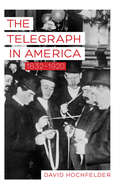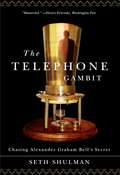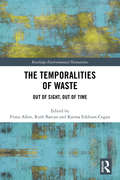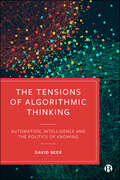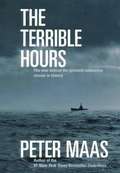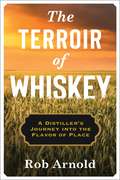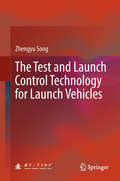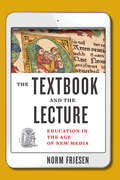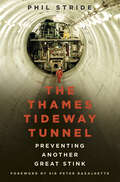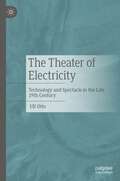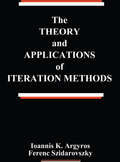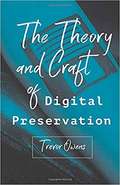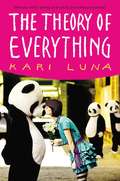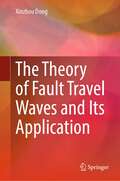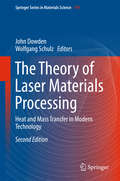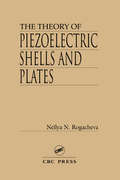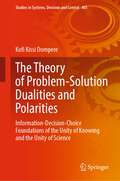- Table View
- List View
The Telecommunications Handbook
by Kornel Terplan Patricia MorrealeA panel of renowned experts from around the world contributed to this authoritative handbook that covers the essential aspects of this most dynamic field of communications and networking activity. Edited by Dr. Kornel Terplan and Patricia Morreale - well known authorities in telecommunications- this important new handbook provides basic principles and definitions, details the tremendous advances in technology, outlines implementation techniques, and discusses the outstanding issues and key challenges faced by communications and networking specialists.The telecommunications topics addressed include:o Basic principles o Services on broadband networks o Signal processing and coding schemes o Mobile and wireless networks o DSL technologies o Digital video and multimedia o Quality of service o Regulation o Standards o Emerging technologiesExhaustive in scope and packed with diagrams, tables, and illustrations, The Telecommunications Handbook is an indispensable, detailed reference for engineers, analysts, managers, and students involved in a wide range of telecommunication and networking activities.
The Telecommunications Illustrated Dictionary
by Julie K. PetersenFrom fundamental physics concepts to the World Wide Web, the Telecommunications Illustrated Dictionary, Second Edition describes protocols, computer and telephone devices, basic security concepts, and Internet-related legislation, along with capsule biographies of the pioneering inventors who developed the technologies that changed our world. The new edition offers even more than the acclaimed and bestselling first edition, including:Thousands of new definitions and existing definitions updated and expanded Expanded coverage, from telegraph and radio technologies to modern wireline and mobile telephones, optical technologies, PDAs, and GPS-equipped devicesMore than 100 new charts and illustrationsExpanded appendices with categorized RFC listingsCategorized charts of ITU-T Series Recommendations that facilitate online lookupsHundreds of Web URLs and descriptions for major national and international standards and trade organizationsClear, comprehensive, and current, the Telecommunications Illustrated Dictionary, Second Edition is your key to understanding a rapidly evolving field that, perhaps more than any other, shapes the way we live.
The Telegraph in America, 1832–1920 (Johns Hopkins Studies in the History of Technology)
by David HochfelderA complete history of how the telegraph revolutionized technological practice and life in America.Telegraphy in the nineteenth century approximated the internet in our own day. Historian and electrical engineer David Hochfelder offers readers a comprehensive history of this groundbreaking technology, which employs breaks in an electrical current to send code along miles of wire. The Telegraph in America, 1832–1920 examines the correlation between technological innovation and social change and shows how this transformative relationship helps us to understand and perhaps define modernity. The telegraph revolutionized the spread of information—speeding personal messages, news of public events, and details of stock fluctuations. During the Civil War, telegraphed intelligence and high-level directives gave the Union war effort a critical advantage. Afterward, the telegraph helped build and break fortunes and, along with the railroad, altered the way Americans thought about time and space. With this book, Hochfelder supplies us with an introduction to the early stirrings of the information age.
The Telephone Gambit: Chasing Alexander Graham Bell's Secret
by Seth ShulmanA gripping intrigue at the heart of one of the world's most important inventions. While researching Alexander Graham Bell at MIT's Dibner Institute, Seth Shulman scrutinized Bell's journals and within them he found the smoking gun, a hint of deeply buried historical intrigue. Delving further, Shulman unearthed the surprising story behind the invention of the telephone: a tale of romance, corruption, and unchecked ambition. Bell furtively--and illegally--copied part of Elisha Gray's invention in the race to secure what would become the most valuable U.S. patent ever issued. And afterward, as Bell's device led to the world's largest monopoly, the American Telephone and Telegraph Company, he hid his invention's illicit beginnings. In The Telephone Gambit, Shulman challenges the reputation of an icon of invention, rocks the foundation of a corporate behemoth, and offers a probing meditation on how little we know about our own history.
The Temporalities of Waste: Out of Sight, Out of Time (Routledge Environmental Humanities)
by Ruth Barcan Fiona Allon Karma Eddison-CoganThis book investigates the complex and unpredictable temporalities of waste. Reflecting on waste in the context of sustainability, materiality, social practices, subjectivity and environmental challenges, the book covers a wide range of settings, from the municipal garbage crisis in Beirut, to food rescue campaigns in Hong Kong and the toxic by-products of computer chip production in Silicon Valley. Waste is one of the most pressing issues of the day, central to environmental challenges and the development of healthier and more sustainable futures. The emergence of the new field of discard studies, in addition to expanding research across other disciplines within the social sciences, is testament to the centrality of waste as a crucial social, material and cultural problem and to the need for multi- and transdisciplinary approaches like those provided in this volume. This edited collection seeks to develop a framework that understands the material properties of different kinds of waste, not as fixed, stable or singular but asdynamic, relational and often invisible. It brings together new and cutting-edge research on the temporalities of waste by a diverse range of international authors. Collectively, this research presents a persuasive argument about the need to give more credence to the capacities of waste to provoke us in materially and temporally complex ways, especially those substances that complicate our understandings of life as bounded duration. This book will be of great interest to students and scholars of the environmental humanities, cultural studies, anthropology and human geography.
The Tensions of Algorithmic Thinking: Automation, Intelligence and the Politics of Knowing
by David BeerWe are living in algorithmic times. From machine learning and artificial intelligence to blockchain or simpler newsfeed filtering, automated systems can transform the social world in ways that are just starting to be imagined. Redefining these emergent technologies as the new systems of knowing, pioneering scholar David Beer examines the acute tensions they create and how they are changing what is known and what is knowable. Drawing on cases ranging from the art market and the smart home, through to financial tech, AI patents and neural networks, he develops key concepts for understanding the framing, envisioning and implementation of algorithms. This book will be of interest to anyone who is concerned with the rise of algorithmic thinking and the way it permeates society.
The Terrible Hours
by Peter MaasOn the eve of World War II, the Squalus, America's newest submarine, plunged into the North Atlantic. Miraculously, thirty-three crew members still survived. While their loved ones waited in unbearable tension on shore, their ultimate fate would depend upon one man, U.S. Navy officer Charles "Swede" Momsen-an extraordinary combination of visionary, scientist, and man of action. In this thrilling true narrative, prize-winning author Peter Maas brings us in vivid detail a moment-by-moment account of the disaster and the man at its center. Could he actually pluck those men from a watery grave? Or had all his pioneering work been in vain?
The Terroir of Whiskey: A Distiller's Journey Into the Flavor of Place (Arts and Traditions of the Table: Perspectives on Culinary History)
by Rob ArnoldLook at the back label of a bottle of wine and you may well see a reference to its terroir, the total local environment of the vineyard that grew the grapes, from its soil to the climate. Winemakers universally accept that where a grape is grown influences its chemistry, which in turn changes the flavor of the wine. A detailed system has codified the idea that place matters to wine. So why don’t we feel the same way about whiskey?In this book, the master distiller Rob Arnold reveals how innovative whiskey producers are recapturing a sense of place to create distinctive, nuanced flavors. He takes readers on a world tour of whiskey and the science of flavor, stopping along the way at distilleries in Kentucky, New York, Texas, Ireland, and Scotland. Arnold puts the spotlight on a new generation of distillers, plant breeders, and local farmers who are bringing back long-forgotten grain flavors and creating new ones in pursuit of terroir. In the twentieth century, we inadvertently bred distinctive tastes out of grains in favor of high yields—but today’s artisans have teamed up to remove themselves from the commodity grain system, resurrect heirloom cereals, bring new varieties to life, and recapture the flavors of specific local ingredients. The Terroir of Whiskey makes the scientific and cultural cases that terroir is as important in whiskey as it is in wine.
The Test and Launch Control Technology for Launch Vehicles
by Zhengyu SongThis book presents technologies and solutions related to the test and launch control of rockets and other vehicles, and offers the first comprehensive and systematic introduction to the contributions of the Chinese Long March (Chang Zheng in Chinese, or abbreviated as CZ) rockets in this field. Moreover, it discusses the role of this technology in responsive, reliable, and economical access to space, which is essential for the competitiveness of rockets. The need for rapid development of the aerospace industry for both governmental and commercial projects is addressed. This book is a valuable reference resource for practitioners, and many examples and resources are included, not only from Chinese rockets but also from many other vehicles. It covers guidelines, technologies, and solutions on testing and launch control before rocket takeoff, covering equipment-level testing, system-level testing, simulation tests, etc.
The Tetris Effect: The Cold War Battle for the World's Most Addictive Game
by Dan Ackerman21 February 1989. Three men fly into Moscow, representing software giants from Britain, America, and Japan. Each of them is determined to undercut the others in order to secure a technology so powerfully addictive it has brought the government department that created it to a standstill. In a country on the brink of seismic change, where spycraft is about to give way to cut-throat capitalism, Tetris has become the grand prize. Featuring corporate espionage, unmarked government organizations, courtroom drama and international conspiracies, the origin of the world&’s most popular video game is a gripping, fast-paced thriller of the highest order. Not only this, but it is also the tale of a one-in-a-million software start-up – a unique example of an idea, a product, and an era coming together at exactly the right moment. Tetris was perfectly (if accidentally) crafted to hit primal triggers in our minds and in Ackerman&’s hands its story is unputdownable.
The Texas City Disaster, 1947
by Hugh W. StephensOn April 16, 1947, a small fire broke out among bags of ammonium nitrate fertilizer in the hold of the ship Grandcamp as it lay docked at Texas City, Texas. Despite immediate attempts to extinguish the fire, it rapidly intensified until the Grandcamp exploded in a blast that caused massive loss of life and property. In the ensuing chaos, no one gave much thought to the ship in the next slip, the High Flyer. It exploded sixteen hours later. The story of the Texas City explosions-America's worst industrial disaster in terms of casualties-has never been fully told until now. In this book, Hugh W. Stephens draws on official reports, newspaper and magazine articles, personal letters, and interviews with several dozen survivors to provide the first full account of the disaster at Texas City. Stephens describes the two explosions and the heroic efforts of Southeast Texans to rescue survivors and cope with extensive property damage. At the same time, he explores why the disaster occurred, showing how a chain of indifference and negligence made a serious industrial accident almost inevitable, while a lack of emergency planning allowed it to escalate into a major catastrophe. This gripping, cautionary tale holds important lessons for a wide reading public.
The Textbook and the Lecture: Education in the Age of New Media (Tech.edu: A Hopkins Series on Education and Technology)
by Norm FriesenWhy do the basic technologies of education—the book and the lecture—endure in our digital age?Why are the fundamentals of education apparently so little changed in our era of digital technology? Is their obstinate persistence evidence of resilience or obsolescence? Such questions can best be answered not by imagining an uncertain high-tech future, but by examining a well-documented past—a history of instruction and media that extends from Gilgamesh to Google. Norm Friesen looks to the combination and reconfiguration of oral, textual, and more recent media forms to understand the longevity of so many educational arrangements and practices.Friesen examines the interrelationship of reading, writing, and pedagogy in the case of the lecture and the textbook—from their premodern to their postmodern incarnations. Over hundreds of years, these two forms have integrated textual, oral, and (more recently) digital media and connected them with changing pedagogical and cultural priorities. The Textbook and the Lecture opens new possibilities for understanding not only mediated pedagogical practices and their reform but also gradual changes in our conceptions of the knowing subject and of knowledge itself.Drawing on wide-ranging scholarship in fields as diverse as media ecology and German-language media studies, Foucauldian historiography, and even archaeological research, The Textbook and the Lecture is a fascinating investigation of educational media.
The Thames Tideway Tunnel: Preventing Another Great Stink
by Phil StrideUnderneath the River Thames, one of the UK’s largest-ever underground engineering projects is taking shape. In 1858 the ‘Great Stink of London’ made much of the city along the River Thames uninhabitable. Between 1848 and 1854 nearly 25,000 Londoners died of cholera, a disease borne by foul water. Joseph Bazalgette saved the city, building sewers that would serve 4 million people and stop waste water emptying into the Thames. These remarkable sewers are still the backbone of London’s sewerage system today, but the city’s population is now approaching 10 million. The old sewers can’t cope with the needs of modern-day London and action needs to be taken to ensure that ‘The Great Stink’ never happens again. This is where the Thames Tideway Tunnel comes in: a £4.2 billion, 25km-long, 7.2m-diameter tunnel that will stop virtually all of the sewer overflows into the Thames and give us a cleaner and healthier river and city. The Thames Tideway Tunnel: Preventing Another Great Stink is the inside story on the tunnel, from the very start to breaking ground and all the steps along the way. Written by Phil Stride, a leading civil engineer, it is a unique chance both to see behind the scenes of an incredible civil engineering project that will transform the environment, and to meet the people who’ve taken the project forward over the last ten years.
The Thames at War: Saving London From the Blitz
by Gustav MilneThis illustrated WWII history pays tribute to the engineers and emergency repair teams who saved London from flooding during the relentless air raids.Between 1940 and 1945 London suffered persistent Nazi air raids, bringing widespread destruction both day and night. Meanwhile, there lurked another devastating threat: the possibility of widespread flooding if the Nazi onslaught ever breached the Thames’ river defenses. The Thames at War sheds light on the vital role of the London County Council emergency repair teams and the unsung achievements of their leader, Chief Engineer Thomas Peirson Frank, who time and again saved the capital from drowning. Historian Gustav Milne also explores the fate of London’s docks and bridges, as well as the ships, boats and barges lost in the estuary and tideway.
The Theater of Electricity: Technology and Spectacle in the Late 19th Century
by Ulf OttoSince the 1880s, electrical energies started circulating in European theaters, generated from fossil fuels in urban power plants. A mysterious force, which was still traded as romantic life force by some and for others had already come to stand in for progress, entered performance venues. Engineering knowledge, control techniques and supply chains changed fundamentally how theater was made and thought of. The mechanical image machine from Renaissance and Baroque times was transformed into a thermodynamic engine. Modern theater turned out to be electrified theater. – Retracing what happened backstage before the Avantgarde took to the front stage, this book proposes to write the genealogy of theaters modernity as a cultural history of theater technology.
The Theory and Applications of Iteration Methods (Systems Engineering Ser. #4)
by Ferenc Szidarovszky Ioannis K. ArgyrosThe Theory and Applications of Iteration Methods focuses on an abstract iteration scheme that consists of the recursive application of a point-to-set mapping. Each chapter presents new theoretical results and important applications in engineering, dynamic economic systems, and input-output systems. At the end of each chapter, case studies and numerical examples are presented from different fields of engineering and economics. Following an outline of general iteration schemes, the authors extend the discrete time-scale Liapunov theory to time-dependent, higher order, nonlinear difference equations. The monotone convergence to the solution is examined in and comparison theorems are proven . Results generalize well-known classical theorems, such as the contraction mapping principle, the lemma of Kantorovich, the famous Gronwall lemma, and the stability theorem of Uzawa. The book explores conditions for the convergence of special single- and two-step methods such as Newton's method, modified Newton's method, and Newton-like methods generated by point-to-point mappings in a Banach space setting. Conditions are examined for monotone convergence of Newton's methods and their variants. Students and professionals in engineering, the physical sciences, mathematics, and economics will benefit from the book's detailed examples, step-by-step explanations, and effective organization.
The Theory and Craft of Digital Preservation
by Trevor OwensMany people believe that what is on the Internet will be around forever. At the same time, warnings of an impending "digital dark age" ”where records of the recent past become completely lost or inaccessible” appear with regular frequency in the popular press. It's as if we need a system to safeguard our digital records for future scholars and researchers. Digital preservation experts, however, suggest that this is an illusory dream not worth chasing. Ensuring long-term access to digital information is not that straightforward; it is a complex issue with a significant ethical dimension. It is a vocation. <p><p> In The Theory and Craft of Digital Preservation, librarian Trevor Owens establishes a baseline for practice in this field. In the first section of the book, Owens synthesizes work on the history of preservation in a range of areas (archives, manuscripts, recorded sound, etc.) and sets that history in dialogue with work in new media studies, platform studies, and media archeology. In later chapters, Owens builds from this theoretical framework and maps out a more deliberate and intentional approach to digital preservation. <p><p> A basic introduction to the issues and practices of digital preservation, the book is anchored in an understanding of the traditions of preservation and the nature of digital objects and media. Based on extensive reading, research, and writing on digital preservation, Owens's work will prove an invaluable reference for archivists, librarians, and museum professionals, as well as scholars and researchers in the digital humanities.
The Theory and Practice of Online Learning
by Terry AndersonIn this important collection of essays by practitioners and scholars that has been downloaded nearly half a million times is an overview of some of the most pressing issues in online education. By addressing transformations arising from educational technology advances and the new business conditions and modes of delivery of education, the contributors to The Theory and Practice of Online Learning provide insights into this complex, diverse, and rapidly evolving field.
The Theory of Constraints: Applications in Quality Manufacturing, Second Edition (Quality and Reliability)
by Robert E. SteinAiming to change the paradigms of traditional management strategies, this work attempts to create an improved platform within the total quality management umbrella for supporting the profit motive by offering hands-on instructions for applying the theory of constraints in the manufacturing system. The book provides updated information in each area
The Theory of Everything
by Kari LunaOne part Libba Bray's GOING BOVINE, two parts String Theory, and three parts love story equals a whimsical novel that will change the way you think about the world. Sophie Sophia is obsessed with music from the late eighties. She also has an eccentric physicist father who sometimes vanishes for days and sees things other people don't see. But when he disappears for good and Sophie's mom moves them from Brooklyn, New York, to Havencrest, Illinois, for a fresh start, things take a turn for the weird. Sophie starts seeing things, like marching band pandas, just like her dad. Guided by Walt, her shaman panda, and her new (human) friend named Finny, Sophie is determined to find her father and figure out her visions, once and for all. So she travels back to where it began--New York City and NYU's physics department. As she discovers more about her dad's research on M-theory and her father himself, Sophie opens her eyes to the world's infinite possibilities--and her heart to love. Perfect for fans of Going Bovine, The Perks of Being a Wallflower, Scott Pilgrim vs. The World and The Probability of Miracles.
The Theory of Fault Travel Waves and Its Application
by Xinzhou DongThe book starts from the existed problems in fault analysis of the lumped-parameter circuit model. It firstly introduces the basic electromagnetic phenomenon, uniform transmission line guided electromagnetic waves, multi-conductor system guided electromagnetic waves, fault generated travelling waves; then it introduces series of the traveling waves based protections, which includes principle, technology and application in practical power grid; it also discusses the travelling waves based fault location and the travelling waves based fault feeder selector in China. It systemically reveals the essential features of the fault traveling wave and concludes the analytical solutions of the transient fault traveling waves and the modulus maxima representation of the dyadic wavelet transform of fault traveling waves. Finally, the book analyzes the acquisition of traveling waves and the sensor’s characteristics. A unique fault travelling wave test device has been invented based on the theories of the book and will be applied in real systems.
The Theory of Laser Materials Processing
by Wolfgang Schulz John DowdenTheuseoflasersinmaterialsprocessinghasbecomewidespreadinrecent years, sothatanunderstandingofthenatureofheatandmasstransferin thisbranchofmoderntechnologyisofincreasingimportance. Theaimofthe authorsofthisbookistoconcentrateonthephysicalprocesses;thesecanbe developedfromamathematicalpointofview, orfromdirectexperimental- derivedobservation. Thetwoapproachesarecomplementary;eachcanprovide insightsandthesynthesisofthetwocanleadtoaverypowerfulunderstanding oftheprocessesinvolved. Mathematicalmodellingofphysicalprocesseshas hadanimportantroletoplayinthedevelopmentoftechnologyoverthe centuriesandparticularlysointhelastonehundredand?ftyyearsorso. Itcanbearguedthatitismoreimportanttodaythaneverbeforesincethe availabilityofhigh-speedcomputersallowsaccuratenumericalsimulationof industrialprocessesatafractionofthecostofthecorrespondingexperiments. Thisisoneaspectofmathematicalmodelling, highpro?leandmuchvalued, butitisnottheonlyone. Inthepastmathematicalmodellinghadtorelyonqualitativeinves- gation, veryspecialanalyticalsolutions, orinaccurateandtime-consuming calculationsperformedwithlittleinthewayoftabulatedormechanical assistance. Logtablesandsliderulesarestillrememberedbypeopleworking today, thoughtherearesurelyfewwhoregrettheirdisappearance. Thevalueanddistinctivefunctionofmethodsbasedontheanalytical approachisnowbecomingmuchclearer, nowthattheyarenolongerexpected toproducedetailedimitationsofwhathappensinrealexperimentsofind- trialprocesses, afunctionnowful?lledmostlybynumericalmethods, c- sideredbelow. Theemphasistodayisontheirabilitytocon?rmandextend ourunderstandingofthebasicphysicalmechanismsinvolvedintheprocesses of interest. These are essential for any intelligent use of numerical simulation. Theargumentaboutthevalueofteachingpeoplehowtodoarithmetic themselveswithouttheaidofacalculatorseemstobepassingintohistory, vi Preface butitisanimportantoneandprovidesasimpleanalogy. Ifsomeonedoes nothaveafeelingfornumbersandthewayarithmeticworks, theywillalltoo easilyfailtospotanerrorproducedbyamachine. Computersarenotinfallible andneitherarethosewhobuildorprogramthem. Computersarenow takingonlessmundanemathematicaltasksandthesamecontroversiesare appearinginconnectionwithalgebraicmanipulation. Equally, andwitheven greaterpenaltiesintermsofcostintheeventoferrors, thesameconsiderations applytonumericalsimulationofmajorindustrialprocesses. Awarenessofthe analyticalsolutionscanbeinvaluableindistinguishingtherightfromthe wrong, i. e. forthepractitionertounderstandthebasisofthework, andto haveanideaofthekindsofoutcomesthatareplausible andtorecognise thosewhicharenot. Thephrase mathematicalmodelling is, however, ambiguous, perhaps morenowthanithaseverbeen. Thereisanenormousamountofworkdone todayonsimulationbasedontheuseofverypowerfulcomputerprograms, anditisquitecorrectlyreferredtoasmathematicalmodelling. Theprograms aresometimesconstructedin-housebutareusuallycommercialpackages. This isanentirelyvalidapproachwithspeci?c(generallycommercial)objectives. Ingeneraltherearetwouses. Thedominantobjectiveisnumericalagreement withaparticularexperimentinthe?rstinstance, leadingtopredictivec- mercialuseinthesecondinstance. Thesecondobjectiveistheclari?cation ofphysicalmechanisms, aimedatthegenerationofunderstandingofcomplex interconnectedprocesses, ratherthantheexactreproductionofaparticular experiment. Itissometimesoverlookedthat, withsu?cientcare, anum- icalapproachisequallyvalidintheinvestigationofphysicalfundamentals. Numericalsimulationisnotacentraltopicofthisbook, butbecauseofits crucialimportancetoeachofthetwousestowhichnumericalmodellingcan beput, itisvitalthatthecomputationalbasisoftheworkshouldbec- pletelysound. Inaddition, thelevelofprocessdetailwhichcanbeconsidered bythenumericalapproachusuallyexceedswhatispossiblewiththeanaly- calapproachsigni?cantly, leavinglittlechoicebuttoreverttothenumerical treatmentwheninvestigatingtheinterconnectionsbetweenprocesses. Itis forthesereasonsthatthebookconcludeswithachapteroncomprehensive numericalsimulati
The Theory of Linear Viscoelasticity (Dover Books on Physics)
by D. R. BlandThis concise introduction to the concepts of viscoelasticity focuses on stress analysis. Three detailed individual sections present examples of stress-related problems. In addition, it explains procedures for model fitting to measured values of complex modulus or compliance.The text begins with an introduction to the concepts of viscoelasticity. Succeeding chapters explore the foundations of three-dimensional linear viscoelasticity and stress analysis. Sinusoidal oscillation problems, quasi-static problems, and dynamic problems receive particular attention. The final chapter examines model fitting to measured values of complex modulus or compliance. Numerous examples and figures illuminate the text.
The Theory of Piezoelectric Shells and Plates
by Nellya N. RogachevaThis is the first book devoted to a systematic description of the linear theory of piezoelectric shells and plates theory. The book contains two parts. In the first part, the theories for electroelastic thin-walled elements of arbitrary form with different directions of preliminary polarization are presented in an easy form for practical use. The approximate methods for integrating the equations of piezoelectric shells and plates are developed and applied for solving some engineering problems. In the second part, the theory of piezoelectric shells and plates is substantiated by the asymptotic method. The area of applicability for different kinds of electroelastic shell theories is studied. A new problem concerning the electroelastic phenomena at the edge of a thin-walled element is raised and solved.The Theory of Piezoelectric Shells and Plates will be valuable to researchers working in the field of electroelasticity as well as to electrical and electronic engineers who use thin-walled piezoelements. It is also be helpful for students and post-graduates specializing in mechanics and for scientists concerning asymptotic methods.
The Theory of Problem-Solution Dualities and Polarities: Information-Decision-Choice Foundations of the Unity of Knowing and the Unity of Science (Studies in Systems, Decision and Control #405)
by Kofi Kissi DompereThis book is concerned with the development of the understanding of the relational structures of information, knowledge, decision–choice processes of problems and solutions in the theory and practice regarding diversity and unity principles of knowing, science, non-science, and information–knowledge systems through dualistic-polar conditions of variety existence and nonexistence. It is a continuation of the sequence of my epistemic works on the theories on fuzzy rationality, info-statics, info-dynamics, entropy, and their relational connectivity to information, language, knowing, knowledge, cognitive practices relative to variety identification–problem–solution dualities, variety transformation–problem–solution dualities, and variety certainty–uncertainty principle in all areas of knowing and human actions regarding general social transformations. It is also an economic–theoretic approach in understanding the diversity and unity of knowing and science through neuro-decision–choice actions over the space of problem–solution dualities and polarities. The problem–solution dualities are argued to connect all areas of knowing including science and non-science, social science, and non-social-science into unity with diversities under neuro-decision–choice actions to support human existence and nonexistence over the space of static–dynamic dualities. The concepts of diversity and unity are defined and explicated to connect to the tactics and strategies of decision–choice actions over the space of problem–solution dualities. The concepts of problem and solution are defined and explicated not in the space of absoluteness but rather in the space of relativity based on real cost–benefit conditions which are shown to be connected to the general parent–offspring infinite process, where every solution generates new problem(s) which then generates a search for new solutions within the space of minimum–maximum dualities in the decision–choice space under the principle of non-satiation over the space of preference–non-preference dualities with analytical tools drawn from the fuzzy paradigm of thought which connects the conditions of the principle of opposites to the conditions of neuro-decision–choice actions in the zone of variety identifications and transformations. The Monograph would be useful to all areas of Research, Learning and Teaching at Advanced Stages of Knowing and Knowledge Production.


